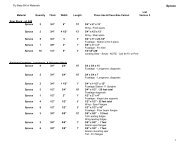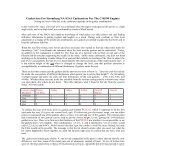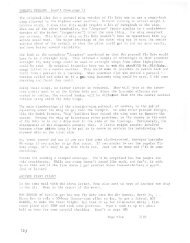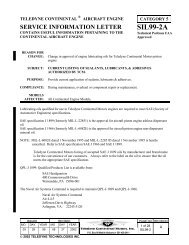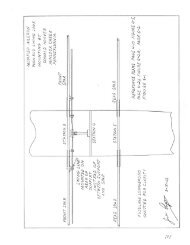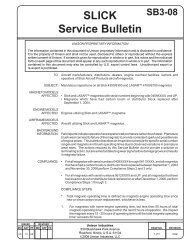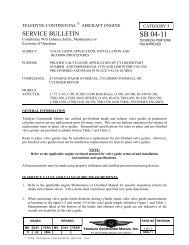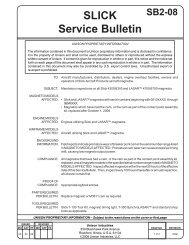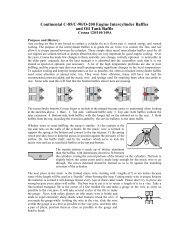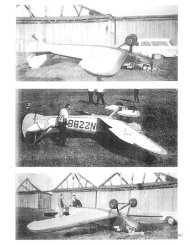SB03-3 - Continental Motors
SB03-3 - Continental Motors
SB03-3 - Continental Motors
You also want an ePaper? Increase the reach of your titles
YUMPU automatically turns print PDFs into web optimized ePapers that Google loves.
The purpose of the cylinder differential pressure test is to IDENTIFY LEAKS and the SOURCE OF LEAKS,<br />
with the engine under static conditions (not running), using a regulated pressure source. When performing a<br />
cylinder differential pressure test a regulated test pressure of eighty pounds per square inch (80 PSI) is directed<br />
into the cylinder with the piston at top dead center at the end of the compression stroke and the beginning of<br />
the power stroke. Eighty pounds per square inch (80 PSI) is used as a test pressure for safety reasons and is<br />
significantly less than the combustion pressure of 800 to 1000 PSI created during engine operation. Pistons,<br />
piston rings, valves and valve seats rely on combustion forces to assist in creating a complete seal during<br />
engine operation.<br />
NOTE: This static leak check does not relate directly to cylinder pressures developed during actual engine<br />
operations.<br />
The purpose of the cylinder borescope inspection is to provide a visual method of examining the internal<br />
cylinder components and must be used in conjunction with the differential pressure test.<br />
Excess cylinder wall or piston ring wear, broken piston rings and burned valves will normally be evidenced by<br />
additional conditions that must be taken into consideration when determining cylinder condition. These may<br />
include, but may not be limited to:<br />
Excessive cylinder barrel wear and/or piston ring wear:<br />
1. Elevated crankcase pressure; reference the latest revision of TCM Service Bulletin M89-9.<br />
2. Increased oil consumption. See note on page 9.<br />
3. Oil becoming discolored within first 10 hours after an oil change.<br />
4. High iron content in oil analysis may be an indication.<br />
Broken piston rings:<br />
1. Scored, grooved cylinder wall, evident via a borescope inspection.<br />
2. Abnormal debris in oil filter or oil screen.<br />
3. High iron content in oil analysis may be an indication.<br />
Burned Valves:<br />
1. Usually results in differential leak test reading in the 0/80 to 40/80 range.<br />
2. Easily identifiable during borescope inspection.<br />
Additionally, many variables affect what a technician sees from a differential pressure test reading. These<br />
variables include, but are not limited to:<br />
1. Abnormal amounts of oil in cylinder.<br />
2. Temperature of the engine and the uniformity of cylinder temperature at the time the differential<br />
pressure test is performed.<br />
3. Accuracy of the test equipment being used.<br />
4. Capacity and pressure output of the source of compressed air and the techniques used by the<br />
technician when performing the test.<br />
ISSUED REVISED PAGE NO REVISION<br />
MO DAY YEAR MO DAY YEAR 2 of 14<br />
03 28 2003<br />
P.O. Box 90 Mobile Alabama • 251-438-3411<br />
<strong>SB03</strong>-3



